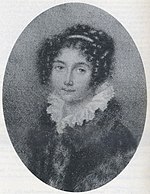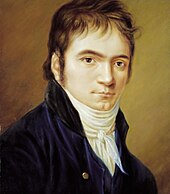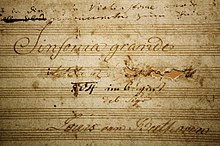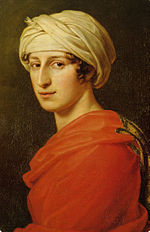Tagagamit:Tagasalinero/burador

Noon g May 1799, he taught piano to the daughters of Hungarian Countess Anna Brunsvik. During this time, he fell in love with the younger daughter Josephine. Amongst his other students, from 1801 to 1805, he tutored Ferdinand Ries, who went on to become a composer and later wrote about their encounters. The young Carl Czerny, who later became a renowned music teacher himself, studied with Beethoven from 1801 to 1803. In late 1801, he met a young countess, Julie Guicciardi, through the Brunsvik family; he mentions his love for Julie in a November 1801 letter to a friend, but class difference prevented any consideration of pursuing this. He dedicated his 1802 Sonata Op. 27 No. 2, now commonly known as the Moonlight Sonata, to her.[1]
In the spring of 1801 he completed The Creatures of Prometheus, a ballet. The work received numerous performances in 1801 and 1802, and he rushed to publish a piano arrangement to capitalise on its early popularity.[2] In the spring of 1802 he completed the Second Symphony, intended for performance at a concert that was cancelled. The symphony received its premiere instead at a subscription concert in April 1803 at the Theater an der Wien, where he had been appointed composer in residence. In addition to the Second Symphony, the concert also featured the First Symphony, the Third Piano Concerto, and the oratorio Christ on the Mount of Olives. Reviews were mixed, but the concert was a financial success; he was able to charge three times the cost of a typical concert ticket.[3]
His business dealings with publishers also began to improve in 1802 when his brother Kaspar, who had previously assisted him casually, began to assume a larger role in the management of his affairs. In addition to negotiating higher prices for recently composed works, Kaspar also began selling some of his earlier unpublished compositions and encouraged him (against Beethoven's preference) to also make arrangements and transcriptions of his more popular works for other instrument combinations. Beethoven acceded to these requests, as he could not prevent publishers from hiring others to do similar arrangements of his works.[4]
1802–1812: The 'heroic' period
[baguhin | baguhin ang wikitext]Deafness
[baguhin | baguhin ang wikitext]
Beethoven told the English pianist Charles Neate (in 1815) that he dated his hearing loss from a fit he suffered in 1798 induced by a quarrel with a singer.[5] During its gradual decline, his hearing was further impeded by a severe form of tinnitus.[6] As early as 1801, he wrote to Wegeler and another friend Karl Amenda, describing his symptoms and the difficulties they caused in both professional and social settings (although it is likely some of his close friends were already aware of the problems).[7] The cause was probably otosclerosis, perhaps accompanied by degeneration of the auditory nerve.[8][n 1]
On the advice of his doctor, Beethoven moved to the small Austrian town of Heiligenstadt, just outside Vienna, from April to October 1802 in an attempt to come to terms with his condition. There he wrote the document now known as the Heiligenstadt Testament, a letter to his brothers which records his thoughts of suicide due to his growing deafness and records his resolution to continue living for and through his art. The letter was never sent and was discovered in his papers after his death.[12] The letters to Wegeler and Amenda were not so despairing; in them Beethoven commented also on his ongoing professional and financial success at this period, and his determination, as he expressed it to Wegeler, to "seize Fate by the throat; it shall certainly not crush me completely".[8] In 1806, Beethoven noted on one of his musical sketches: "Let your deafness no longer be a secret – even in art."[13]
Beethoven's hearing loss did not prevent him from composing music, but it made playing at concerts—an important source of income at this phase of his life—increasingly difficult. (It also contributed substantially to his social withdrawal.)[8] Czerny remarked however that Beethoven could still hear speech and music normally until 1812.[14] Beethoven never became totally deaf; in his final years he was still able to distinguish low tones and sudden loud sounds.
The 'heroic' style
[baguhin | baguhin ang wikitext]
Beethoven's return to Vienna from Heiligenstadt was marked by a change in musical style, and is now often designated as the start of his middle or "heroic" period characterised by many original works composed on a grand scale.[15] According to Carl Czerny, Beethoven said: "I am not satisfied with the work I have done so far. From now on I intend to take a new way."[16] An early major work employing this new style was the Third Symphony in E flat Op. 55, known as the Eroica, written in 1803–04. The idea of creating a symphony based on the career of Napoleon may have been suggested to Beethoven by Count Bernadotte in 1798.[17] Beethoven, sympathetic to the ideal of the heroic revolutionary leader, originally gave the symphony the title "Bonaparte", but disillusioned by Napoleon declaring himself Emperor in 1804, he scratched Napoleon's name from the manuscript's title page, and the symphony was published in 1806 with its present title and the subtitle "to celebrate the memory of a great man".[18] The Eroica was longer and larger in scope than any previous symphony. When it premiered in early 1805 it received a mixed reception. Some listeners objected to its length or misunderstood its structure, while others viewed it as a masterpiece.[19]

Other middle period works extend in the same dramatic manner the musical language Beethoven had inherited. The Rasumovsky string quartets, and the Waldstein and Appassionata piano sonatas share the heroic spirit of the Third Symphony.[18] Other works of this period include the Fourth through Eighth Symphonies, the oratorio Christ on the Mount of Olives, the opera Fidelio, and the Violin Concerto.[20] Beethoven was hailed in 1810 by the writer and composer E. T. A. Hoffmann, in an influential review in the Allgemeine musikalische Zeitung, as the greatest of (what he considered) the three "Romantic" composers, (that is, ahead of Haydn and Mozart); in Beethoven's Fifth Symphony his music, wrote Hoffmann, "sets in motion terror, fear, horror, pain, and awakens the infinite yearning that is the essence of romanticism".[21]
During this time Beethoven's income came from publishing his works, from performances of them, and from his patrons, for whom he gave private performances and copies of works they commissioned for an exclusive period before their publication. Some of his early patrons, including Prince Lobkowitz and Prince Lichnowsky, gave him annual stipends in addition to commissioning works and purchasing published works.[22] Perhaps his most important aristocratic patron was Archduke Rudolf of Austria, the youngest son of Emperor Leopold II, who in 1803 or 1804 began to study piano and composition with him. They became friends, and their meetings continued until 1824.[23] Beethoven dedicated 14 compositions to Rudolf, including some of his major works such as the Archduke Trio Op. 97 (1811) and Missa solemnis Op. 123 (1823).
His position at the Theater an der Wien was terminated when the theatre changed management in early 1804, and he was forced to move temporarily to the suburbs of Vienna with his friend Stephan von Breuning. This slowed work on Leonore, (his original title for his opera), his largest work to date, for a time. It was delayed again by the Austrian censor and finally premiered, under its present title of Fidelio in November 1805 to houses that were nearly empty because of the French occupation of the city. In addition to being a financial failure, this version of Fidelio was also a critical failure, and Beethoven began revising it.[24]
Despite this failure, Beethoven continued to attract recognition. In 1807 the musician and publisher Muzio Clementi secured the rights for publishing his works in England, and Haydn's former patron Prince Esterházy commissioned a mass (the Mass in C, Op. 86) for his wife's name-day. But he could not count on such recognition alone. A colossal benefit concert which he organized in December 1808, and was widely advertised, included the premieres of the Fifth and Sixth (Pastoral) symphonies, the Fourth Piano Concerto, extracts from the Mass in C, the scena and aria Ah! perfido Op. 65 and the Choral Fantasy op. 80. There was a large audience, (including Czerny and the young Ignaz Moscheles). But it was under-rehearsed, involved many stops and starts, and during the Fantasia Beethoven was noted shouting at the musicians "badly played, wrong, again!" The financial outcome is unknown.[25]

In the autumn of 1808, after having been rejected for a position at the Royal Theatre, Beethoven had received an offer from Napoleon's brother Jérôme Bonaparte, then king of Westphalia, for a well-paid position as Kapellmeister at the court in Cassel. To persuade him to stay in Vienna, Archduke Rudolf, Prince Kinsky and Prince Lobkowitz, after receiving representations from Beethoven's friends, pledged to pay him a pension of 4000 florins a year.[26] In the event, Archduke Rudolf paid his share of the pension on the agreed date.[27] Kinsky, immediately called to military duty, did not contribute and died in November 1812 after falling from his horse.[28][29] The Austrian currency destabilized and Lobkowitz went bankrupt in 1811 so that to benefit from the agreement Beethoven eventually had recourse to the law, which in 1815 brought him some recompense.[30]
The imminence of war reaching Vienna itself was felt in early 1809. In April Beethoven had completed writing his Piano Concerto No. 5 in E flat major, Op. 73,[28] which the musicologist Alfred Einstein has described as "the apotheosis of the military concept" in Beethoven's music.[31] Archduke Rudolf left the capital with the Imperial family in early May, prompting Beethoven's piano sonata Les Adieux, (Sonata No. 26, Op. 81a), actually entitled by Beethoven in German "Das Lebewohl" (The Farewell), of which the final movement, "Das Wiedersehen" (The Return), is dated in the manuscript with the date of Rudolf's homecoming of 30 January 1810.[32] During the French bombardment of Vienna in May Beethoven took refuge in the cellar of the house of his brother Kaspar.[33] The subsequent occupation of Vienna and the disruptions to cultural life and to Beethoven's publishers, together with Beethoven's poor health at the end of 1809, explain his significantly reduced output during this period,[34] although other notable works of the year include his String Quartet No. 10 in F major, Op. 74 (known as The Harp) and the Piano Sonata No. 24 in F sharp major op. 78, dedicated to Josephine's sister Therese Brunsvik.[35]
Goethe
[baguhin | baguhin ang wikitext]
At the end of 1809 Beethoven was commissioned to write incidental music for Goethe's play Egmont. The result (an overture, and nine additional entractes and vocal pieces, Op. 84), which appeared in 1810 fitted well with Beethoven's "heroic" style and he became interested in Goethe, setting three of his poems as songs (Op. 83) and learning about the poet from a mutual acquaintance, Bettina Brentano (who also wrote to Goethe at this time about Beethoven). Other works of this period in a similar vein were the F minor String Quartet Op. 95, to which Beethoven gave the subtitle Quartetto serioso, and the Op. 97 Piano Trio in B flat major known, from its dedication to his patron Rudolph as the Archduke Trio.[36]
In the spring of 1811, Beethoven became seriously ill, suffering headaches and high fever. His doctor Johann Malfatti recommended him to take a cure at the spa of Teplitz (now Teplice in Czechia) where he wrote two more overtures and sets of incidental music for dramas, this time by August von Kotzebue – King Stephen Op. 117 and The Ruins of Athens Op. 113. Advised again to visit Teplitz in 1812 he met there with Goethe, who wrote: "His talent amazed me; unfortunately he is an utterly untamed personality, who is not altogether wrong in holding the world to be detestable, but surely does not make it any more enjoyable ... by his attitude." Beethoven wrote to his publishers Breitkopf and Härtel that "Goethe delights far too much in the court atmosphere, far more than is becoming in a poet."[36] But following their meeting he began a setting for choir and orchestra of Goethe's Meeresstille und glückliche Fahrt (Calm Sea and Prosperous Voyage) (Op. 112), completed in 1815. After this was published in 1822 with a dedication to the poet, Beethoven wrote to him: "The admiration, the love and esteem which already in my youth I cherished for the one and only immortal Goethe have persisted."[37]
"The Immortal Beloved"
[baguhin | baguhin ang wikitext]
While he was at Teplitz in 1812 he wrote a ten-page love letter to his "Immortal Beloved", which he never sent to its addressee.[38] The identity of the intended recipient was long a subject of debate, although the musicologist Maynard Solomon has convincingly demonstrated that the intended recipient must have been Antonie Brentano; other candidates have included Julie Guicciardi, Therese Malfatti and Josephine Brunsvik.[39] [n 2]
All of these had been regarded by Beethoven as possible soulmates during his first decade in Vienna. Guicciardi, although she flirted with Beethoven, never had any serious interest in him and married Wenzel Robert von Gallenberg in November 1803. (Beethoven insisted to his later secretary and biographer, Anton Schindler, that Gucciardi had "sought me out, crying, but I scorned her".)[41] Josephine had since Beethoven's initial infatuation with her married the elderly Count Joseph Deym, who died in 1804. Beethoven began to visit her and commenced a passionate correspondence. Initially, he accepted that Josephine could not love him, but he continued to address himself to her even after she had moved to Budapest, finally demonstrating that he had got the message in his last letter to her of 1807: "I thank you for wishing still to appear as if I were not altogether banished from your memory".[42] Malfatti was the niece of Beethoven's doctor, and he had proposed to her in 1810. He was 40, she was 19 – the proposal was rejected.[43] She is now remembered as the recipient of the piano bagatelle Für Elise.[44][n 3]
Antonie (Toni) Brentano (née von Birkenstock), ten years younger than Beethoven, was the wife of Franz Brentano, the half-brother of Bettina Brentano, who provided Beethoven's introduction to the family. It would seem that Antonie and Beethoven had an affair during 1811–1812. Antonie left Vienna with her husband in late 1812 and never met with (or apparently corresponded with) Beethoven again, although in her later years she wrote and spoke fondly of him.[46]
After 1812 there are no reports of any romantic liaisons of Beethoven; it is, however, clear from his correspondence of the period and, later, from the conversation books, that he would occasionally resort to prostitutes.[47]
- ↑ Steblin 2009.
- ↑ Cooper 2008, pp. 98–103.
- ↑ Cooper 2008, pp. 112–27.
- ↑ Cooper 2008, pp. 112–15.
- ↑ Solomon 1998, p. 160.
- ↑ Swafford 2014, pp. 223–24.
- ↑ Cooper 2008, p. 108.
- ↑ 8.0 8.1 8.2 Kerman, Tyson & Burnham 2001, § 5.
- ↑ Stevens 2013, pp. 2854–2858.
- ↑ Stevens, M. H.; Jacobsen, T.; Crofts, A. K. (2013). "Lead and the deafness of Ludwig van Beethoven". The Laryngoscope. 123 (11): 2854–8. doi:10.1002/lary.24120. PMID 23686526. S2CID 34595828. Nakuha noong 2020-10-21.
{{cite journal}}: CS1 maint: date auto-translated (link) - ↑ Oiseth 2015, pp. 139–47.
- ↑ Cooper 1996, pp. 169–172.
- ↑ Solomon 1998, p. 162.
- ↑ Ealy 1994, p. 262.
- ↑ Tyson 1969, p. 138–141.
- ↑ Cooper 2008, p. 131.
- ↑ Kerman, Tyson & Burnham 2001, § 4.
- ↑ 18.0 18.1 Kerman, Tyson & Burnham 2001, § 6.
- ↑ Cooper 2008, p. 148.
- ↑ Kerman, Tyson & Burnham 2001, § 14 and 15.
- ↑ Cassedy 2010, pp. 1–6.
- ↑ Cooper 2008, pp. 78–79.
- ↑ Lockwood 2005, pp. 300–01.
- ↑ Cooper 2008, p. 150.
- ↑ Thayer 1967a, pp. 445–448.
- ↑ Thayer 1967a, p. 457.
- ↑ Cooper 2008, p. 195.
- ↑ 28.0 28.1 Cooper 1996, p. 48.
- ↑ Cooper 2008, p. 48.
- ↑ Solomon 1998, p. 194.
- ↑ Einstein 1958, p. 47.
- ↑ Thayer 1967a, p. 464.
- ↑ Thayer 1967a, p. 465.
- ↑ Thayer 1967a, p. 467–473.
- ↑ Thayer 1967a, p. 475.
- ↑ 36.0 36.1 Kerman, Tyson & Burnham 2001, § 7.
- ↑ Cooper 1996, p. 47.
- ↑ Brandenburg 1996, p. 582.
- ↑ Cooper 1996, p. 107.
- ↑ Solomon 1998, pp. 223–231.
- ↑ Solomon 1998, pp. 196–197.
- ↑ Solomon 1998, pp. 197–199.
- ↑ Solomon 1998, p. 196.
- ↑ Cooper 1996, p. 20.
- ↑ Thayer 1967a, p. 502.
- ↑ Solomon 1998, pp. 231–239.
- ↑ Solomon 1998, pp. 284, 339–340.
Maling banggit (May <ref> tag na ang grupong "n", pero walang nakitang <references group="n"/> tag para rito); $2

